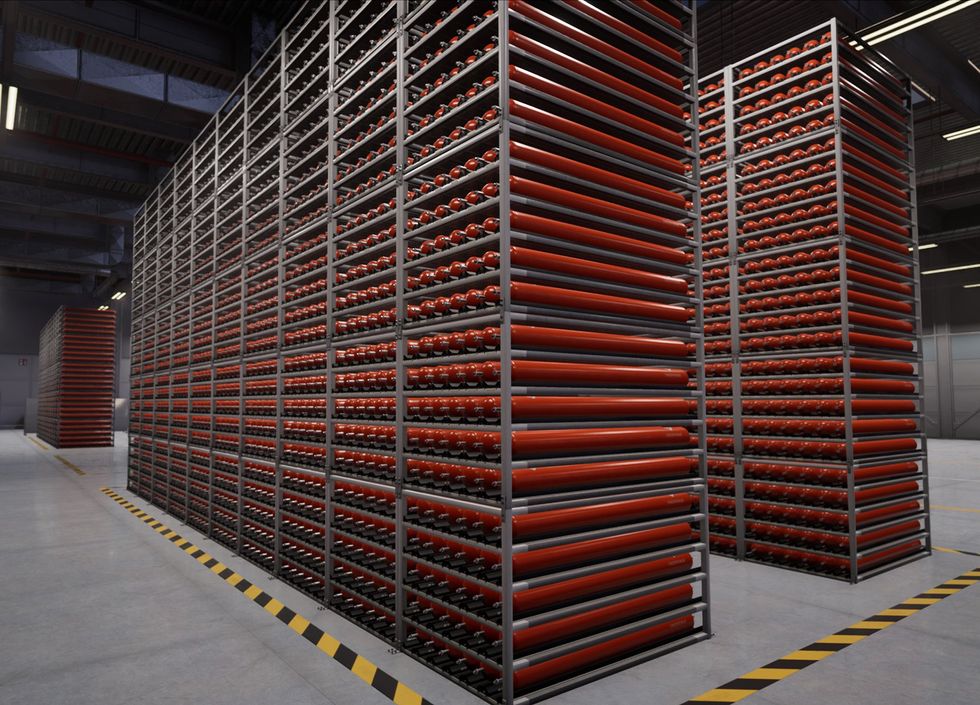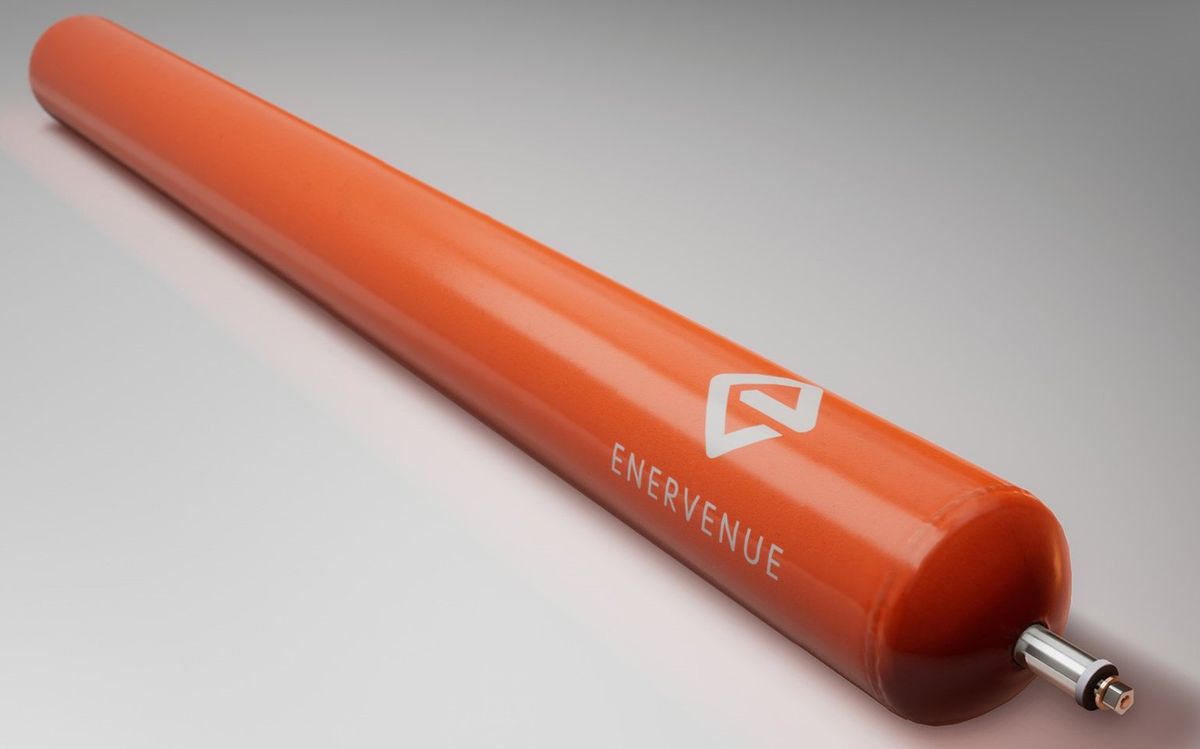Technologies for space are designed to be tough, safe, and long-lasting. So what happens when you bring the battery chemistry deployed on the International Space Station, nickel-hydrogen, down to Earth?
“[It’s] the most durable battery ever invented,” says Jorg Heinemann. Nickel-hydrogen batteries, he says, can last for 30,000 charge cycles, are fireproof, and outperform lithium-ion batteries on a number of key metrics for energy storage at the large scale.
Heinemann is CEO of EnerVenue, a nickel-hydrogen battery manufacturer based in Fremont, Calif. “Our cost is comparable to where lithium-ion is going, and we use earth-abundant materials,” he says. “Nickel is the most expensive thing we use. We operate at a 90 percent round-trip efficiency, more efficient than lithium-ion. And there’s basically no maintenance on this battery, it was designed for sending up on a rocket ship into outer space.”
Nickel-hydrogen batteries can run for tens of thousands of cycles, giving them a life of over 30 years.
This fall, the company will finish construction of a 92,900-square-meter gigafactory in Kentucky that will start by making up to 5 gigawatt-hours’ worth of batteries annually. He projects the facility will reach its full capacity when it’s churning out 20 GWh of cells per year.
Nickel-hydrogen batteries look and work unlike any other battery. They consist of a stack of electrodes inside a pressurized gas tank. The cathode is nickel hydroxide and the anode is hydrogen. When the battery is charging, a catalytic reaction generates hydrogen gas. During discharge, the hydrogen oxidizes and converts back to water.
The chemistry was designed in the 1970s and chosen for the space program because “there were really no other alternatives then,” Heinemann says. Lithium-ion was in its infancy and lasted for about 200 cycles, while lead-acid lasted around 500.
Nickel-hydrogen batteries can run for tens of thousands of cycles, giving them a life of over 30 years. Their use of expensive platinum catalysts kept them relegated to space applications until five years ago, when Stanford materials science and engineering professor and battery entrepreneur Yi Cui’s team found an inexpensive nickel-molybdenum-cobalt alloy catalyst for the battery that costs US $20 per kilogram.
Cui helped launch EnerVenue in 2020 and is now the startup’s chairman and chief technology officer. The company’s newest-generation batteries, revealed in early September, are tanks measuring 1.8 meters long (6 feet) and 15 centimeters wide (6 inches) with an energy capacity of 3 kWh, Heinemann says.
“I call it the barbecue test. We take the battery, put it in an open fire, and watch it continue to heat up.”
—Jorg Heinemann, EnerVenue
Needing a pressurized vessel raises eyebrows, he adds, but the reactions are very stable, and as hydrogen gas builds up inside the tank, it reaches a peak pressure that is about 5 percent of what a hydrogen fuel cell would typically reach. The nature of the chemistry is such that if the pressure continues to rise past the maximum, it forces the recombination of hydrogen back into water. So there is no mechanism for thermal runaway as there is in lithium-ion, where by-products of the reaction can sometimes cause uncontrolled buildup of heat that can cause fires.
“I call it the barbecue test,” Heinemann says. “We take the battery, put it in an open fire, and watch it continue to heat up. What ends up happening is that the pressure above top charge will force the hydrogen back into water. And then we have a release valve designed into the unit, so at a predesigned pressure and temperature that will release, and you’ll get a steam vent.”

Another advantage is that the battery chemistry works across a wide temperature range of –40 to 60 °C. That means any given battery-storage bank requires no costly heating, air-conditioning, ventilation, and fire-suppression systems—all of which require their own maintenance and upkeep, in addition to sapping a company’s bottom line.
Many novel battery technologies are vying for the grid-storage market, and nickel-hydrogen batteries are at least tried and tested in small-scale aerospace applications. But they haven’t been made and tested on a large scale yet, and the new metal-alloy catalyst has yet to prove itself in the real world.
“Like many early-stage technologies, EnerVenue’s nickel-hydrogen batteries currently cost more than lithium-ion batteries,” says Aaron Marks, an energy-storage technology analyst at Wood Mackenzie. “They also have lower energy density, meaning more space and more batteries are needed for the same power rating.” But, he adds, their less-intensive manufacturing process may provide a key advantage for companies like EnerVenue to ramp up manufacturing. The batteries’ relative safety and long life should also make them very competitive. “Once the technology reaches scale, it will help make the entire technology landscape better and cheaper just by virtue of providing real competition,” Marks says.
So far, EnerVenue has been operating a pilot production line that can manufacture 100 megawatt-hours’ worth of batteries per year—and they’ve deployed small-scale test systems. But, says Heinemann, the company already has over 7 GWh, or about $400 million dollars’ worth of purchase orders, including from solar energy developer Pine Gate Renewables and Schlumberger New Energy. “Our mission,” he says, “Is to become the No. 1 provider of stationary storage serving power plants, businesses, and homes globally.”
- It’s Still Early, but Potassium Batteries Are Showing Promise for Grid Storage ›
- EVs Are Essential Grid-Scale Storage ›
Prachi Patel is a freelance journalist based in Pittsburgh. She writes about energy, biotechnology, materials science, nanotechnology, and computing.



